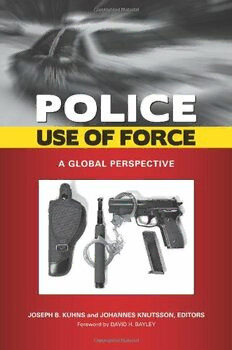
Police Use of Force: A Global Perspective (Global Crime and Justice) PDF
Preview Police Use of Force: A Global Perspective (Global Crime and Justice)
Police Use of Force RecentTitlesin GlobalCrimeandJustice OutsmartingtheTerrorists RonaldV.ClarkeandGraemeR.Newman HumanTrafficking,HumanMisery:TheGlobalTradeinHumanBeings AlexisA.Aronowitz POLICE USE OF FORCE A Global Perspective JOSEPH B. KUHNS AND JOHANNES KNUTSSON, EDITORS FOREWORDBYDAVIDH.BAYLEY GlobalCrimeandJustice GraemeR.Newman,SeriesEditor Copyright2010byJosephB.KuhnsandJohannesKnutsson Allrightsreserved.Nopartofthispublicationmaybereproduced, storedinaretrievalsystem,ortransmitted,inanyformorbyany means,electronic,mechanical,photocopying,recording,orotherwise, exceptfortheinclusionofbriefquotationsinareview,withoutprior permissioninwritingfromthepublisher. LibraryofCongressCataloging-in-PublicationData Policeuseofforce :aglobalperspective/editedbyJosephB.KuhnsandJohannesKnutsson ; forewordbyDavidH.Bayley. p.cm.—(Globalcrimeandjustice) Includesbibliographicalreferencesandindex. ISBN978-0-313-36326-9(hardcopy :alk.paper)—ISBN978-0-313-36327-6(ebook) 1.Police—Attitudes.2.Policebrutality.3.Policemisconduct.I.Kuhns,JosephB.II.Knutsson, Johannes,1947- HV8069.P652010 363.2’32—dc22 2010000171 ISBN: 978-0-313-36326-9 EISBN:978-0-313-36327-6 14 13 12 11 10 1 2 3 4 5 ThisbookisalsoavailableontheWorldWideWebasaneBook. Visitwww.abc-clio.comfordetails. Praeger AnImprintofABC-CLIO,LLC ABC-CLIO,LLC 130CremonaDrive,P.O.Box1911 SantaBarbara,California93116-1911 Thisbookisprintedonacid-freepaper ManufacturedintheUnitedStatesofAmerica Contents SeriesForewordbyGraemeR.Newman ix ForewordbyDavidH.Bayley xiii Acknowledgments xvii PartI:PoliceUseofForce 1 Introduction JosephB.KuhnsandJohannesKnutsson 3 1. Non-LethalForcebyPoliceintheUnitedStates:TheVariousLenses ThroughWhichAppropriatenessIsExamined WilliamTerrillandEugeneA.Paoline,III 6 2. TheUseofForcebyPoliceinPoland EmilW.PływaczewskiandIzabelaNowicka 14 3. PoliceandtheUseofForceinHongKong KamC.Wong 22 4. OfficerSafetyandPublicSafety:TrainingthePolicetoUseForce intheUnitedKingdom JohnW.Buttle 32 5. PhysicalandPsychologicalForceinCriminalandMilitary InterrogationsintheUnitedStates MarkCostanzoandAllisonRedlich 43 vi CONTENTS 6. Police‘‘Encounters’’inMumbai,India JyotiBelur 52 7. ManoDura:FightingCrime,Violence,andInsecuritywith anIronFistinCentralAmerica Marie-LouiseGlebbeek 63 8. SystemicPoliceViolenceinBrazil MarthaK.Huggins 73 PartII:PoliceUseofFirearms 83 Introduction JohannesKnutsson 85 9. PoliceUseofGunsinUnarmedCountries:TheUnitedKingdom P.A.J.WaddingtonandMartinWright 87 10. PoliceUseofGunsinaRoutinelyUnarmedPoliceForce: RegulationsandPracticeinNorway Tor-GeirMyhrerandJonStrype 95 11. PoliceUseofFirearmsinSweden JohannesKnutsson 105 12. PoliceUseofFirearmsintheNordicCountries:AComparison JohannesKnutssonandAnnikaNor(cid:2)ee 115 13. PoliceUseofFirearmsinChina:AnOverviewofaRegulatory Framework KamC.Wong 124 14. DeadlyForceintheUnitedStates GregoryB.Morrison 132 15. AnExplorationofPoliceUseofFirearmsinAustralia DavidBaker 141 16. TheConsequencesofUsingDeadlyForce DavidA.Klinger 152 PartIII:PoliceUseofNon-LethalWeapons 163 Introduction JosephB.Kuhns 165 17. PepperSpray:Practice,Policy,andResearchintheNetherlands RobertJ.KaminskiandOttoAdang 167 CONTENTS vii 18. PoliceUseoftheTASERintheUnitedStates:Research, Controversies,andRecommendations MichaelD.WhiteandJustinReady 177 19. CurrentlyAvailableLess-than-LethalAlternativesand EmergingTechnologiesfortheFuture DianaL.SummersandJosephB.Kuhns 188 Conclusion:AJourneyThroughtheWorldofPoliceUseofForce EdwardR.Maguire 199 Notes 213 Appendix 221 References 225 Index 255 AbouttheEditorsandContributors 259 This page intentionally left blank Series Foreword THIS FASCINATING AND diverse book in the Global Crime and Justice series fol- lows an earlier title, Human Trafficking, Human Misery, a book that high- lighted this crime’s international proportions, and the challenge it posed to police who were faced with the problem that often the offenders they appre- hended (illegal immigrants) were also victims (trafficked into prostitution or forced labor). They were both innocent and guilty at the same time. As this book shows, however, the problem of the innocence and guilt of suspects is a universal, indeed core problem that faces all policing, at least modern polic- ing. It is deeply tied to the use of force by the State. It is a philosophical and political problem that is played out in the daily actions of police as they per- form their duty. Force, and the use of it, is rather like water. Without it, we could achieve little. We could not build houses, roads, or skyscrapers. We could not trans- port ourselves to faraway places. Indeed, without it, societies would collapse. Great philosophers have tried in vain to construct ways in which societies could function without force, and revolutionaries have, contradictorily, tried to impose these grand political visions on people in many lands. The thinkers of the 18th century enlightenment following Hobbes, particularly Rousseau, Locke, and Hume, finally had to acknowledge that the State was a necessary, though distasteful, body for imposing peace and order in societies. It was Locke, following Montesquieu, who first clearly recognized though that force had itself to be controlled, and this could be achieved by the ‘‘separation of powers.’’ This principle has become the linchpin of the rule of law, embedded in the United States political system and Constitution (i.e., the legislative, judicial, and executive branches). Indeed, it is embedded in the constitutions
